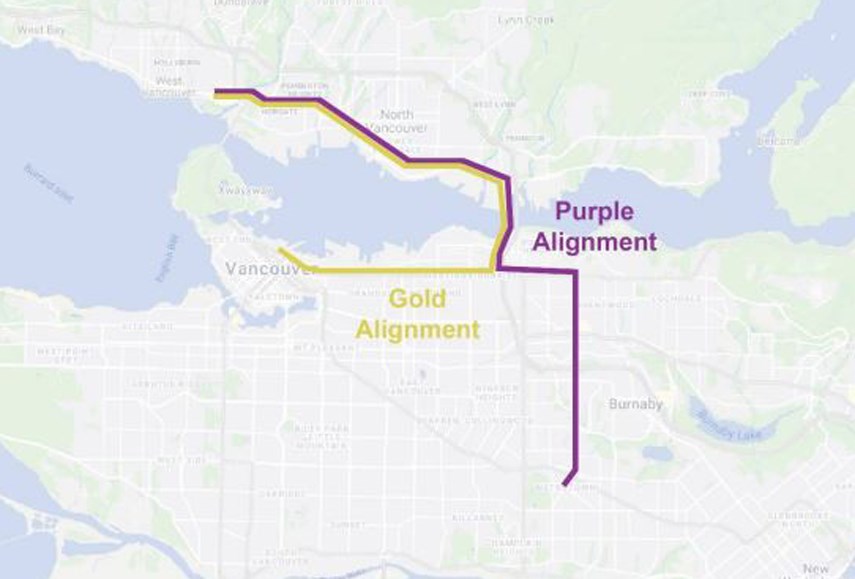The North Shore’s three municipal governments and two First Nations are putting up a united front when it comes to bringing rapid transit to the North Shore.
Leaders from the District of West Vancouver, Sḵwx̱wú7mesh Úxwumixw (Squamish Nation), City of North Vancouver, District of North Vancouver and səlilil̓ w̓ətaʔɬ (Tsleil-Waututh Nation) met in Lower Lonsdale Tuesday to announce the formation of North Shore Connects.
“We've heard loud and clear from residents, both here and across the region, who want to see improvements to transit and transportation infrastructure. It's the No. 1 priority of our communities,” said West Vancouver Mayor Mary-Ann Booth, who is chairing North Shore Connects. “Our No. 1 goal is to bring rapid transit over Burrard Inlet to the North Shore as soon as possible.”
The group’s genesis is in INSTPP, the Integrated North Shore Transportation Planning Project, which brought together each level of government to research and put forward options for addressing the North Shore’s transportation problems. INSTPP commissioned feasibility studies, which identified at least five potential routes for hypothetical Burrard Inlet Rapid Transit (BIRT) line, and an economic impact study. With the launch of North Shore Connects, that study has now been released.
Among its conclusions: Adding a rapid transit connection over the Second Narrows connecting either to Vancouver via Hastings Street or Burnaby’s Metrotown via Willingdon could shift more than 50,000 vehicle trips per day off the two North Shore bridges, reducing congestion, emissions and collisions. Other hypothetical lines under or over Burrard Inlet connecting to downtown straight from Lower Lonsdale or West Vancouver appear to be off the table.
“I think the North Shore mayors…are really focusing on the east,” Booth said. “There's a lot of detail to be worked out around technology and alignments.”
A rapid transit line across the inlet could also double the number of jobs accessible within a 60-minute transit ride for North Shore residents, the study found, and it would spur connectivity for four First Nations reserves on the North Shore.
Beyond giving their membership easier access to their home communities and services, Squamish Nation chairperson Khelsilem underscored the environmental imperative of shifting commuters to transit.
“Our Squamish people care very deeply about our environment and the actions we take to address the climate crisis,” he said.
The launch of North Shore connects follows TransLink’s Transport 2050 draft plan, which foresees the expansion rapid transit around Metro Vancouver. Actually getting a line built will require the blessing of the TransLink Mayors’ Council plus funding from senior levels of government. North Shore Connects will present their studies’ findings to TransLink and the region’s mayors with the goal of prioritizing BIRT for the next round of transit expansion.
“We need the people who live work and play on the North Shore, along with businesses, big and small, to join our call,” city Mayor Linda Buchanan said.
Whonoak (Dennis Thomas), elected Tsleil-Waututh council member, stressed the good that would come to his community and everyone in the Lower Mainland.
“It's really important that we have this rapid transit line interconnect the different cultural dynamic hubs, east to west corridors in all of North Vancouver, connecting to Burnaby, Metro Vancouver,” he said.
DNV Mayor Mike Little, meanwhile, emphasized the threat our current traffic problems pose to business, both local and national.
“While the North Shore is fortunate to have a strong economy, transportation challenges and their impact on employee retention and reliability puts this at risk. North Shore Connects makes accessibility a priority, helping workers at the ports, students at Capilano University, and employees in other industries get to where they need to go in a timely and affordable manner,” he said.
Beyond persuading the region’s mayors that the North Shore should be next in line for rapid transit improvements, North Shore Connects has other transportation goals in mind. The group is working together on plans for a potential road crossing over the Capilano River, linking Park Royal with West First Street in North Vancouver, which would alleviate congestion on Marine Drive.



